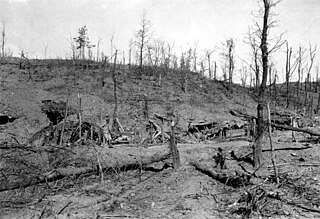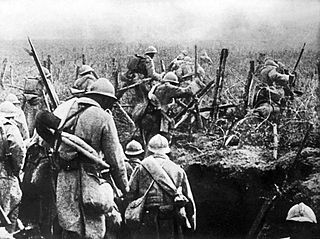| 7. Armee 7th Army | |
|---|---|
 Cap Badge | |
| Active | May 1915 – April 1918 |
| Country | |
| Type | Field Army |
| Engagements | World War I |
The Austro-Hungarian Seventh Army was an Austro-Hungarian field army that fought during World War I.
| 7. Armee 7th Army | |
|---|---|
 Cap Badge | |
| Active | May 1915 – April 1918 |
| Country | |
| Type | Field Army |
| Engagements | World War I |
The Austro-Hungarian Seventh Army was an Austro-Hungarian field army that fought during World War I.
The Austro-Hungarian Seventh Army was formed in May 1915 and deployed on the Russian Front. It remained active there until it was disbanded in April 1918.
It participated in the

The Brusilov offensive, also known as the June advance, or Battle of Galicia-Volhynia, of June to September 1916 was the Russian Empire's greatest feat of arms during World War I, and among the most lethal offensives in world history. The historian Graydon Tunstall called the Brusilov offensive the worst crisis of World War I for Austria-Hungary and the Triple Entente's greatest victory, but it came at a tremendous loss of life. It was arguably the most successful offensive in the entirety of the First World War. The victory contributed to a morale upsurge among the Russian troops, in 1917, Nicholas II planned a general offensive along the entire front in order to end the Central Powers. After the victory, the Petrograd conference was held at which the post-war structure of the world was discussed. Even despite the losses, the Russian armies were still being reinforced with new forces, the number of weapons increased, and new railways were being built. The result of the battle will fully restore Russia's prestige among the allies, which forced them to make serious territorial concessions, such as Anatolia and Constantinople, the French government confirmed the possibility of the Russians themselves to choose which territories to tear away from Germany after the war.

The Eastern Front or Eastern Theater of World War I was a theater of operations that encompassed at its greatest extent the entire frontier between Russia and Romania on one side and Austria-Hungary, Bulgaria, the Ottoman Empire, and Germany on the other. It ranged from the Baltic Sea in the north to the Black Sea in the south, involved most of Eastern Europe, and stretched deep into Central Europe. The term contrasts with the Western Front, which was being fought in Belgium and France. Unlike the static warfare on the Western Front, the fighting on the geographically larger Eastern Front was more dynamic, often involving the flanking and encirclement of entire formations, and resulted in over 100,000 square miles of territory becoming occupied by a foreign power.

Svetozar Boroević von Bojna was an Austro-Hungarian field marshal who was described as one of the finest defensive strategists of the First World War. He commanded Austro-Hungarian forces in the Isonzo front, for which he was nicknamed the "Lion of Isonzo".

The Polish Legions was a name of the Polish military force established in August 1914 in Galicia soon after World War I erupted between the opposing alliances of the Triple Entente on one side and the Central Powers on the other side, comprising the German Empire and Austria-Hungary. The Legions became "a founding myth for the creation of modern Poland" in spite of their considerably short existence; they were replaced by the Polish Auxiliary Corps formation on 20 September 1916, merged with Polish II Corps in Russia on 19 February 1918 for the Battle of Rarańcza against Austria-Hungary, and disbanded following the military defeat at the Battle of Kaniów in May 1918, against Imperial Germany. General Haller escaped to France to form the Polish army in the West against the anti-Polish German-Bolshevik treaty.

The 1st Army was a field army-level command in the ground forces of Austria-Hungary during World War I. The army fought in Galicia and Russian Poland in 1914–15 before being briefly dissolved in the summer of 1916. Shortly afterwards, it was reformed and sent to fight in the Romanian Campaign for the next two years. The 1st Army was demobilized in April 1918 due to its heavy losses, following Romania's surrender.

The Südtirol Offensive, also known as the Battle of Asiago or Battle of the Plateaux, wrongly nicknamed Strafexpedition "Punitive expedition", was a major offensive launched by the Austro-Hungarians on the territory of Vicentine Alps in the Italian Front on 15 May 1916, during World War I. It was an "unexpected" attack that took place near Asiago in the province of Vicenza after the Fifth Battle of the Isonzo.

World War I or the First World War, also known as the Great War, was a global conflict between two coalitions: the Allies and the Central Powers. Fighting took place mainly in Europe and the Middle East, as well as in parts of Africa and the Asia-Pacific, and in Europe was characterised by trench warfare; the widespread use of artillery, machine guns, and chemical weapons (gas); and the introductions of tanks and aircraft. World War I was one of the deadliest conflicts in history, resulting in an estimated 10 million military dead and more than 20 million wounded, plus some 10 million civilian dead from causes including genocide. The movement of large numbers of people was a major factor in the deadly Spanish flu pandemic.

The Gorlice–Tarnów offensive during World War I was initially conceived as a minor German offensive to relieve Russian pressure on the Austro-Hungarians to their south on the Eastern Front, but resulted in the Central Powers' chief offensive effort of 1915, causing the total collapse of the Russian lines and their retreat far into Russia. The continued series of actions lasted the majority of the campaigning season for 1915, starting in early May and only ending due to bad weather in October.

Generaloberst Arthur Freiherr Arz von Straußenburg was an Austro-Hungarian colonel general and last Chief of the General Staff of the Austro-Hungarian Army. At the outbreak of the First World War, he commanded the 15th Infantry Division. Soon, he was promoted to the head of the 6th Corps and the First Army. He participated on the Gorlice–Tarnów Offensive in 1915 and the countryside of Romania in 1916. In March 1917, he became Chief of the General Staff until his resignation on 3 November 1918.

Although a member of the Triple Alliance, Italy did not join the Central Powers – Germany and Austria-Hungary – when the war started with Austria-Hungary's declaration of war on Serbia on 28 July 1914. In fact, the two Central Powers had taken the offensive while the Triple Alliance was supposed to be a defensive alliance. Moreover the Triple Alliance recognized that both Italy and Austria-Hungary were interested in the Balkans and required both to consult each other before changing the status quo and to provide compensation for whatever advantage in that area: Austria-Hungary did consult Germany but not Italy before issuing the ultimatum to Serbia, and refused any compensation before the end of the war.

Viktor Graf von Scheuchenstuel was a colonel general in the Austro-Hungarian Army. He was a general staff officer and division commander until World War I broke out. During World War I he was a Corps and Army commander serving in Serbia, Albania and Italy. During World War I he was promoted to Graf in the Austrian nobility. Following the end of World War I and the end of the Austro-Hungarian Empire, Scheuchenstuel retired from the military. He died in Vienna.

The Great Retreat was a strategic withdrawal and evacuation on the Eastern Front of World War I in 1915. The Imperial Russian Army gave up the salient in Galicia and the Polish Congress Kingdom. The Russian Empire's critically under-equipped military suffered great losses in the Central Powers' July–September summer offensive operations, which led to the Stavka ordering a withdrawal to shorten the front lines and avoid the potential encirclement of large Russian forces in the salient. While the withdrawal itself was relatively well-conducted, it was a severe blow to Russian morale.

The Southwestern Front was an army group of the Imperial Russian Army during World War I as part of the Eastern Front war theater.

Paul Freiherr Puhallo von Brlog was a general of Austria-Hungary. During World War I, he commanded the Austro-Hungarian Army's 3rd and 1st Armies.

The leaders of the Central Powers of World War I were the political or military figures who commanded or supported the Central Powers.
The Army Group Mackensen which operated in Poland between 22 April 1915 and 8 September 1915 during World War I under the command of Field Marshal August von Mackensen, was an army group of the Imperial German Army.

The Austro-Hungarian Fourth Army was an Austro-Hungarian field army that fought during World War I.
The 3rd Army was a field army-level command within the ground forces of Austria-Hungary during World War I. It was primarily active on the Eastern Front against the Russian Empire and in the Balkans against Serbia and Montenegro. Later on, the 3rd Army took part in some fighting on the Italian Front before returning to the eastern theater by 1917 to repulse the Kerensky Offensive. Its remaining units were merged with the 7th Army in January 1918.

Army Group Archduke Karl was an army group of Austria-Hungary during World War I, established in June 1916 to fight against the Russian Empire on the Eastern Front and later in the campaign against the Kingdom of Romania. It was named for its commander, Field Marshal Archduke Karl Franz Joseph, who commanded the formation until October 1916. The following month, he became the last emperor of Austria-Hungary. The army group consisted of the 1st and 7th Armies.

Karl Freiherr von Kirchbach auf Lauterbach, from 1917 Count of Kirchbach auf Lauterbach, was a colonel general of the Austro-Hungarian Army.